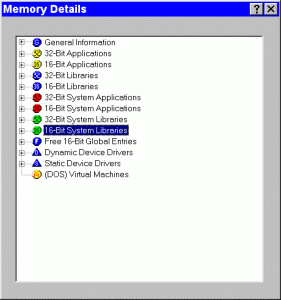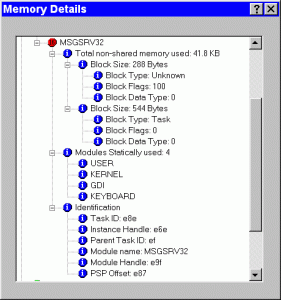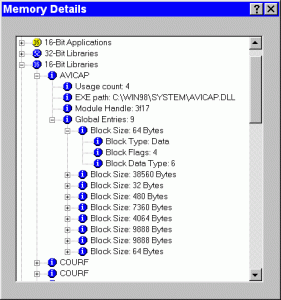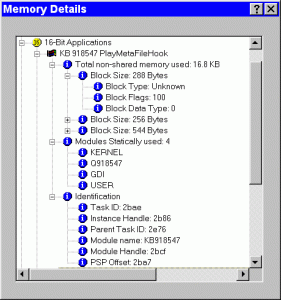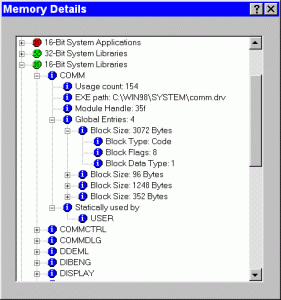
Nomen
MemberContent Type
Profiles
Forums
Events
Everything posted by Nomen
-
This is where I'm finding it:https://msdn.microsoft.com/en-us/magazine/cc301756.aspx
-
I don't know if the info displayed by Norton System Information is what is being sought here, but this is what I see. Under Memory General Information tells me I have 81% free 16-bit User and 93% free 16-bit GDI: If I expand 16-bit system applications, I have only 2 of those (mmtask and msgsrv32). If I fully expand msgsrv32, this is what I get: If I expand the 16-bit libraries, there are many entries. If I expand the first one (avicap) I get this: If I expand 16-bit applications, I have 3 items. If I fully expand the first one, I get: If I expand 16-bit system libraries, there are about 2-dozen of them. If I expand the first one (comm) I get this: I assume that it's the 16-bit items that cause GDI resource issues for win-98. ?
-
Can anyone bring up archive.org using any browser on win-98?
Nomen replied to Nomen's topic in Windows 9x/ME
Jumper wrote: > archive.org redirects to https archive.org and is working (at present) for me on FF2. > archive.org/details/AllAmeri1936 redirects to https archive.org/details/AllAmeri1936 and the looks fine with FF2. > details.archive.org/AllAmeri1936 redirects to http archive.org/AllAmeri1936 but page is blank except for "Page not found We’re sorry, the page you have requested is not available." which is what you are getting. > Twitter is the same. twitter.com redirects to https twitter.com and works for FF2. > details.archive.org/movies is interesting. that one redirects to https archive.org/details/movies but at this point with FF2 all I'm getting is "page reset by peer" errors with any of these various archive.org URL's. I try clearing FF2/network/cache, I try changing my IP, I try changing the user-agent. Still get peer reset error. I close FF2 and restart it, and all archive.org URL's are working again, including https archive.org/details/movies. > In summary, not working in FF2 for me! Try clearing the cache (tools-options-network). -
Can anyone bring up archive.org using any browser on win-98?
Nomen replied to Nomen's topic in Windows 9x/ME
archive.org is working today for both netscape 9 and ff 2. I swear it wasn't working yesterday (as described in my first post). However, I believe I've found a website that is exhibiting the same problem: http://webserve.com/ In netscape and FF I get: Your browser is not accepting header redirects. Please click here (http://www.webserve.com/) It would seem that has nothing to do with ssl, but if you google that message you get stuff like this: Problem with SSL redirects: http://www.silverstripe.org/community/forums/customising-the-cms/show/8835 Looking at what wget does with webserve.com, I can't see any indication that a redirection is intended. -
archive.org (or www.archive.org) seems to perform an immediate redirection to "https://:/". Opera 12.02 also does a redirect to "https://www.archive.org/"but the page comes back as "302 Found / nginx/1.4.6 (Ubuntu)"
-
You probably should have posted your experience with HP 6000 Pro SFF in the win-98 motherboard thread. If all your drives are SATA, and you have working Sata 32-bit driver for win-98, then why do you need to mess with IDE / ESDI_506.pdr? You don't even need to have that file on your system if all your drives are sata and are operating in native sata mode with working win-98 driver. Your HP 6000 has Intel Q43 Express chipset. It appears to have integrated GMA X4500 graphics. Does your HP have on-board graphics, and are there win-98 drivers for it? Can you explain what your driver files are for USB and SATA for win-98? Are you sure you are operating in 32-bit mode for hard-drive access, or is it DOS compatibility mode? You will not find HD-audio driver files for win-98. No motherboard with on-board HD-audio (regardless what chipset it has) has ever seen working win-98 drivers for HD audio component.
-
Norton Utilities System Information (the one I have is SI32.EXE version 15.03.0.36 from Norton System Works 2002) will show some information about GDI resources currently in use.
-
The security / anti-virus software company Kaspersky has made some presentations receitly at security conferences regarding an organized class of malware, the authorship for which they are calling "The Equation Group". It is almost a given that this group is the NSA. I believe that this document will suffice to give sufficient background: http://securelist.com/files/2015/02/Equation_group_questions_and_answers.pdf Kaspersky attempts to lay out a road map or history of development of various system-infection and communication tools dating back to 2001, and part of their explanation is that some of this was specifically developed to work under win-9x/me - specifically a software class that Kaspersky is calling "Equation Drug". From the above document: ---------- EquationDrug’s core modules, designed for hooking deep into the OS, do not contain a trusted digital signature and cannot be run directly on modern operating systems. The code checks whether the OS version predates Windows XP/2003. Some of the plugins were designed originally for use on Windows 95/98/ME. ----------- There is scant information as to just how operable these malware modules were against remote control of win-9x/me prior to 2003, and I think we can assume that if they were discovered back then that they might have been incorporated into Anti-virus definitions without knowing who the authors really were. What is more uncomfortable to know is that this document describes the existance of hard-drive firmware-based malware storage, and there seems to be no AV product in existance that can check for this. Also mentioned is malware storage in the registry itself. I've always been critical of AV/AM software's seeming lack of ability to scan the registry files contained on hard drives that are slaved to known good/working systems. I don't believe that it's possible to perform a competent scan on drive that a windows system has booted from (especially if the windows is some version of NT). For maybe only a few years now, I've sort of resigned myself to the fact that at some point before the year 2020 I'm going to rebuild my various home computers with XP (even if it's XP running under FAT32 - because I simply don't trust NTFS). It's articles and discoveries like this one from Kaspersky that makes me stop and wonder if running XP will ever or could ever be as secure and care-free as it has been these many years with win-98.
-
Firefox 3.6.xx - Losing support from modern websites?
Nomen replied to ironman14's topic in Windows 9x/ME
Has anyone noticed that Youtube has officially gone HTML5 as of today or yesterday? On one of my win-98 systems, I can't play youtube videos with FF 2.0.0.20. But on another system - I can. I apparently have flash 10,3,183,86 installed. -
Firefox 2 not displaying iframe content (should it?)
Nomen replied to Nomen's topic in Windows 9x/ME
When I bring up this page in firefox 2.0.0.20 and Netscape 9.0.0.6: http://www.globemoon.net/iframe-ex.html With firefox I can't see the black box with its own scroll bar that says "C O N G R A T U L A T I O N S !!!! If you can see this page, then your browser supports iFrames." I *can* see that box with Netscape 9.0.0.6. This is my netscape user-agent string, and below that is the firefox user agent: Mozilla/5.0 (Windows; U; Win98; en-US; rv:1.8.1.12) Gecko/20080219 Firefox/2.0.0.12 Navigator/9.0.0.6 Mozilla/5.0 (Windows; U; Win98; en-US; rv:1.8.1.20) Gecko/20081217 Firefox/2.0.0.20 Slightly different version of Gecko - should that / would that make any difference? Now when I bring up this page: http://www.quirksmode.org/iframetest.html I *DO* see "YES" in the text-box immediately to the right of "Iframe:" with firefox, but I don't see the box above that that has "test page in iframe". With netscape, I see the word "Yes" and the box above it. I was thinking that this might have something to do with cross-site or cross-domain security and that perhaps I've disabled iframes in firefox 2.0.0.20 by implimenting some sort of cross-domain security setting or patch. That's the only thing I can think of. Searching on the web for iframe issues with firefox turns up a lot of stuff that must have happened with firefox in 2013 in response to some sort of security issue. Unless I'm not understanding something - it seems to me that iframe functionality was intentionally disabled in some more modern or recent version of firefox (well past version 2) back in 2013. Maybe they brought it back since then - or not. ? Edit: Could this be about disabling scripts inside iframes? The iframe test window on the quirksmode.org page contains a script. -
This has been a problem for years, and I'm pretty sure this used to work, and I don't know if I put something in about:config to break it. So when you go to a page like this: http://www.zerohedge.com/news/2015-01-21/hedge-fund-manager-loses-998-9-months-tells-investors-he-sorry-overzealousness Right after "To Mr. Li's less than sophisticated investors we have a short clip summarizing what just happened:" is an iframe. The code is this: iframe src="//www.youtube.com/embed/-DT7bX-B1Mg?rel=0" frameborder="0" height="281" width="500" /iframe In firefox 2.0.0.20, I just have a blank line where the youtube video should be. In Netscape 9.0.0.6, the video is there and I can play it just fine. In both of them, in about:config, I have the same 2 lines that contain a "frame" setting of any sort. Browser frames enabled (true), and layout.frames.force_resizability (false). If there is another setting that has anything to do with iframes, then it must not have "frame" in the name. I don't think I have any add-ons that mess with iframes. Any ideas?
-
Firefox 3.x + KernelEx: MathML not working properly
Nomen replied to diamant's topic in Windows 9x Member Projects
> Does it look like the following screenshot (with ? instead > of squares with numbers within)? Yes. It did look like that. > Did/do you have already the font arialuni.TTF? Yes, I already did have that font installed and present in /windows/fonts. -
Mozilla SeaMonkey 2.0.14 (Win98) + 2.31 (WinXP) with shared profile on
Nomen replied to xrayer's topic in Windows 9x/ME
I was able to install SeaMonkey 2.32 but regardless how I have the Kex properties set for seamonkey.exe, it gives "exception c06d007eh in module seamonkey.exe at 0187:0040237c".- 1 reply
-
1
-
KernelEx 2022 (Kex22) Test Versions (4.22.26.2)
Nomen replied to jumper's topic in Windows 9x Member Projects
It would be nice if there was a single program or system component that could be agreed upon as being the defacto test-case for a successful KernelEx modification, enhancement, or installation on any or all win-98se systems given some minimum requirement (such as CPU type, installed ram, etc). The more sophisticated, advanced or "challenging" this application program is, the better. -
Firefox 3.x + KernelEx: MathML not working properly
Nomen replied to diamant's topic in Windows 9x Member Projects
SymbolA can be downloaded from here: http://users.teilar.gr/~g1951d/Symbola.zip After unzipping it, install it using Control Panel - Fonts - File - Add new fonts. After doing that, firefox 2 does render all characters on the w3.org page. -
Firefox 3.x + KernelEx: MathML not working properly
Nomen replied to diamant's topic in Windows 9x Member Projects
When I view the math arrows page using Firefox 2.0.0.20 or Netscape Navigator 9.0.0.6, a window pops up saying this: ------------------- To properly display the MathML on this page you need to install the following fonts: CMSY10, CMEX10, Math1, Math2, Math 4. For further information see: http://www.mozilla.org/projects/mathml/fonts ------------------- The page is then rendered, and it appears correct (no question mark symbols) until column 21E, row B. At that location and down, and for the entire next column (21F) I have ? (question mark symbol). Everything else is identical to the sample, for both FF and Netscape. Viewing that page with IE6, I get asked if I want to save or open the file, I select open, and IE spawns Palemoon 3.6.32 where it displays the same as FF and Netscape except that in place of ? character is something wierd. Opera 12.02 also shows the correct arrows up to column 21e row B, and then just a small box character after that. Going to my control panel, fonts, I can find no fonts that are listed in the message (cmsy, cmex, math1, etc). Searching my drive for any file containing "cmsy10" I find: mathfontcmsy10.properties 5kb 4/15/09 program files\mozilla firefox\res\fonts mathfontcmsy10.properties 5kb 2/19/08 program files\netscape\navigator 9\res\fonts Those files are readable in wordpad. They are not binary files. It looks like these fonts are available as part of this k-meleon GREUpdateTree package: http://kmeleon.sourceforge.net/wiki/GREUpdateTree -
KernelEx 2022 (Kex22) Test Versions (4.22.26.2)
Nomen replied to jumper's topic in Windows 9x Member Projects
I ran the 4.5.3.1 installer on my home system a few days ago. Seems to be running ok. Here's a question: What is the most advanced or challenging NT-dependent application program or system component that a Win-98se system with Kex can run in a satisfactory way? Is it some particular browser? It is some particular version of flash player? Or Java JRE? Or some particular version of acrobat reader? -
I'm sure that MS doesn't feel any need to bury 9x any deeper than it already is. I'm sure that MS feels that it *already has* buried 9x about as deep as it can go at least 8 years ago.Regarding the jump from win-8 to win-10, the best speculation so far (and this comes from someone inside MS) is that there is a lot of software that looks at OS version string and if it sees "9" then it immediately assumes Windows 95 or 98.
-
The CorelDraw 9 suite is hands down the best graphics package for win-9x/me. Although I will admit that possibly version 10 or 11 is better - and I lament the fact that I didn't think to get my hands on those versions years ago when they were more available. I believe that version 11 will run on 9x - but that's probably the last version.
-
What do XP printer drivers look like, and where are they located?
Nomen posted a topic in Windows XP
This pertains to XP-pro 32 bit, SP3. Task Manager shows 15 running processes in total (from all users) when system boots up and desktop is ready. I've run some sort of general purpose install package for a new printer (Samsung C410W) which is connected via ethernet on the local lan. After installing the Samsung software, I bring up start, settings, printers and faxes, right-click on the printer, select properties, which spawns a "Samsung C410 Series Properties" window. I click the "print a test page" button. A new window opens: ------------------------- Samsung C410 series Internet Connection Usage Agreement Samsung software may log user interactions and use your IP address and internet connection to transmt data for software updates, troubleshoting problems and to provide improved customer support. The data transmitted to Samsung shall be used in an anonymous and/or aggregate form and may be transferred to a Samsung entity located overseas. Click the link below to review or change the settings that customizes how your internet connection may be used. ( ) I have reviewed and accept the terms of the agreement [ok] ------------------------- Three web-looking links are visible in the window. Two of them spawn a browser to access web content, the third (click here for setup options) opens another window, allowing me to de-select any of the following: - toublehooting system via web content - samsung product improvement study - smart update Even if all 3 are de-selected, I can't leave the Internet connection usage agreement screen without accepting the terms. I can't close it - I can't even find it running with taskmanager, nor with sys internals process explorer. I refuse to agree to the terms of the agreement, so I don't check the agreement box. Watching task manager when I bring up printer properties and try to print test page shows no change. I see no new process pop up that I can kill. The print spooler says there's a page spooling in the queue, but I can't force it to print. If I try to cancel the job, the print job status changes to "Deleting" and remains stuck in that status. If I stop the print spooler service, the Samsung Internet Connection Usage Agreement window remains on-screen. There are 3 SVCHOST processes running, and I can kill them one at a time (killing one of them will spawn a small window with the title "System Shutdown" but the system remains running as I kill the other SVCHOST processes). Even with the three SVCHOST processes killed, the Samsung permissions window is still there. The system remains in this state for about 30 seconds before it goes to black screen and restarts. So I want to uninstall all this Samsung crapware, but I first want to grab whatever files constitutes the "driver" for this printer and put them somewhere so I can put them back later, and hopefully I won't have to deal with the spyware that Samsung has somehow built into their driver. Any ideas? -
And haven't I been saying exactly that?Haven't I been saying that win-9x is invoked from a transient DOS state? How on earth can DOS-era code or functionality be of any use (let alone be REQUIRED) for win-9x to perform it's core functions of supporting Win32 software and 32-bit hardware drivers? You want to run 16-bit DOS-era programs? No problem - Win-9x will create a virtual DOS environment for them - just like most NT versions of windows will. You have only 16-bit drivers for some ancient hardware components? No problem - win-9x might (or will) make use of them (in a way that NT won't or can't) via some sort of DOS layer. That doesn't mean Win-9x is dependant on a dos layer. It means you're running 9x on pathetic hardware. > 9x/ME uses many data tables and variables it inherits from DOS, that is, most > of the DOS data, which remains in use while 9x/ME is running, and which is > returned to DOS control when 9x/ME terminates. The idea or ability to return to the original DOS state after 9x/me terminates is somewhat bogus, because the vast majority of 9x/me use-case situations does not involve returning to this DOS state. When a typical 9x/me computer is turned on, the user expects to go straight into Windows, and when the use-session is ended, the computer is shut down - there is no desire to re-enter the DOS state to perform any tasks or to use the computer in that state. The fact that 9x/me can "remember" the original DOS state and can return to it after terminating windows is hardly something to point to as an indication that DOS forms some sort of crucial layer or foundation *while* 9x is operating.
-
That link provides not a single piece of information explaining how or why IO.sys plays any role in win-9x operation. Once you get past the hangup that win-9x is invoked from a transient DOS state, all these various attempts to explain how DOS code remains a necessary foundation for win-9x to operate simply falls apart.
-
In terms of providing core functions (such as screen, disk/file-system, network and keyboard I/O) to the user shell or Win32 applications, how does Win-9x/me rely on some DOS code or layer to provide those functions?
-
Is the following true? ---------- The architecture of Windows 9x series OS kernel is monolithic. The basic code is considered similar in function to MS-DOS - as a 16/32 bit hybrid, it requires MS-DOS support to operate. ----------- That's from here: http://en.wikipedia.org/wiki/Architecture_of_Windows_9x After being invoked from a transient 16-bit DOS state, does Win-9x _really_ require some form of DOS running at some level? Even if most of what Win-9x does is via 32-bit API functions and hardware drivers?
-
Is there a version of uTorrent that supports UDP trackers that runs on win-98 (with Kex)? (would have to be newer than version 1.8.5 I think)

